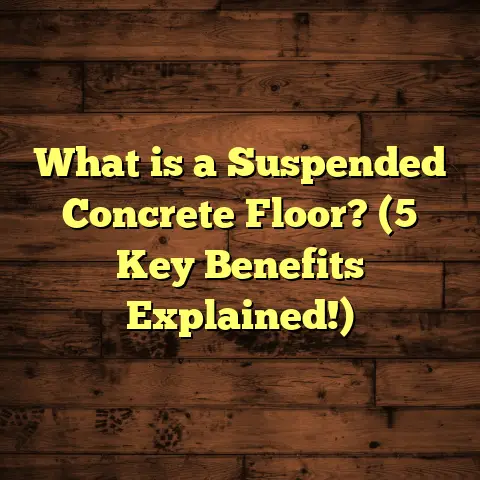What is an Epoxied Floor? (5 Benefits for Long-lasting Durability)
What is an Epoxied Floor?
I want to start by explaining epoxy floors in detail because it’s important to understand what you’re getting into when choosing this material. Epoxy flooring isn’t just a fancy coating slapped on concrete; it’s a carefully engineered system designed to create a durable, attractive surface that stands up to heavy use.
The Basics of Epoxy Flooring
Epoxy is a polymer—basically a type of plastic—that forms when two components, resin and hardener, are mixed together. This chemical reaction causes the mixture to cure, turning into a rigid, solid coating that bonds tightly to the floor beneath it. The floor you see after application is not just a surface layer but becomes part of the structure, reinforcing the floor’s overall strength.
Typically, epoxy floors are applied over concrete, especially in garages, warehouses, factories, and increasingly in homes. Concrete by itself is porous and prone to cracking or staining, but epoxy seals it off completely. The result? A smooth, shiny, and incredibly tough finish.
How Epoxy Floors Are Made
The application process is a bit like painting but with much more preparation and technique involved.
- Surface Preparation: This is the most critical step. The concrete must be cleaned meticulously—free from dust, grease, oil, or any contaminants. Sometimes grinding or etching with acid is needed to roughen the surface so the epoxy adheres well.
- Mixing Resin and Hardener: The two parts of epoxy must be mixed in precise ratios. If mixed incorrectly, the epoxy won’t cure properly.
- Application: The mixed epoxy is poured onto the floor and spread evenly using squeegees or rollers. Multiple coats might be applied depending on the desired thickness and durability.
- Curing: After application, the floor needs time to cure—usually 24 to 72 hours depending on product specifications and environmental conditions.
Throughout my years applying epoxy floors, I’ve learned that skipping or rushing any of these steps can lead to problems later on—like bubbling, peeling, or uneven surfaces.
More Personal Insights
I remember one job early in my career where we rushed surface prep due to tight timelines. The contractor insisted on starting without proper cleaning or etching. A few weeks later, the epoxy started peeling off in large sections. That was a costly lesson: no matter how great the epoxy quality is, poor prep ruins everything.
On the other hand, when I worked with a high-end auto showroom recently, we took extra care with moisture testing before application—because excess moisture under epoxy can cause big issues. The client reported flawless floors even after heavy traffic for over two years.
Types of Epoxy Floors
Epoxy floors come in a few varieties depending on the formulation and finish:
- Solid Epoxy Coatings: The most durable type, often used in industrial settings.
- Quartz-Filled Epoxy: Mixed with quartz granules for extra texture and slip resistance.
- Metallic Epoxy: Contains metallic pigments for a shimmering effect.
- Water-Based Epoxy: Lower in VOCs and better for indoor air quality; good for residential use.
Each has pros and cons depending on where and how you use them.
Five Benefits of Epoxied Floors for Long-lasting Durability
Now that you have a solid understanding of what an epoxy floor is, let me walk you through five key benefits that make epoxied floors stand out—especially when it comes to durability.
1. Unmatched Wear Resistance
One of the main reasons epoxy floors are favored in industrial environments is their incredible hardness. Epoxy coatings can increase floor hardness by up to 80% compared to bare concrete. This means they can resist scratches, impacts, and general wear much better than many other surfaces.
Data-Backed Insight
According to research published by the International Concrete Repair Institute, epoxy-coated floors maintain structural integrity for over a decade in high-traffic areas when installed correctly. This longevity makes them cost-effective despite the initial investment.
My Experience
In warehouses where forklifts and heavy pallets move constantly, I’ve seen epoxy floors last years without major damage. One client told me their epoxy floor survived over five years of daily forklift use without cracks or chips—a feat unheard of with regular concrete.
2. Chemical and Stain Resistance
Epoxy floors repel many chemicals that would otherwise stain or degrade other surfaces. Oils, grease, acids, and solvents tend to just bead up and can be cleaned easily.
Case Study
A chemical manufacturing plant I worked with required flooring that could withstand spills without corroding. We used an industrial-grade epoxy system tailored for chemical resistance. Over three years of operation with regular exposure to harsh substances showed zero staining or damage.
Why This Matters at Home
You might not be handling industrial chemicals at home but think about your garage or kitchen spills—gasoline leaks from lawn mowers or food stains from cooking accidents. Epoxy’s resistance makes cleanup effortless while protecting your floor’s appearance.
3. Simple Maintenance Saves Time and Money
One huge advantage I personally appreciate about epoxy floors is how low maintenance they are.
Unlike tile grout lines that trap dirt or carpets that stain easily, epoxy floors are seamless—no cracks or crevices where dust or mold can grow.
Statistics from Commercial Cleaning Studies
Studies from commercial cleaning companies show epoxy floors reduce cleaning time by nearly 50% versus tile or vinyl floors because you just sweep and mop without scrubbing grout lines or dealing with stains.
A Personal Story
I installed epoxy flooring in my own garage five years ago. It still looks fresh with minimal effort—just weekly sweeping and occasional mopping with mild detergent. No waxing or polishing needed like hardwood floors require.
4. Safety Through Customization
Epoxy flooring isn’t just durable—it can help prevent accidents too.
By adding anti-slip aggregates like fine quartz sand into the epoxy mix, you create texture that reduces slipping risks without sacrificing smoothness or shine.
Real-World Example
I installed textured epoxy flooring in a daycare center’s playroom where kids frequently spilled water and juice. After adding anti-slip additives, slips dropped dramatically. Parents appreciated knowing their kids were safer on these floors.
5. Environmental Benefits That Matter
Epoxy flooring aligns well with eco-conscious values because it can be formulated with low-VOC products that minimize harmful fumes during installation.
Longevity Equals Sustainability
Long-lasting floors mean fewer replacements over time—translating into less waste sent to landfills and fewer raw materials consumed overall.
According to Green Building Advisor data, durable flooring systems like epoxy floors decrease environmental impact by as much as 30% compared to short-lived flooring materials over their lifecycle.
Challenges You Might Face (And How I Handle Them)
No product is without drawbacks or challenges—and epoxied floors are no exception.
Preparation Is Everything
The biggest challenge I’ve faced repeatedly is ensuring the floor beneath is perfectly prepared. Concrete must be clean, dry, and etched for proper adhesion.
Failing this leads to bubbles, peeling, or uneven surfaces later on—which can ruin your investment quickly.
I always insist on moisture testing before starting. If there’s too much moisture underneath, I recommend moisture barriers or alternative flooring options instead of rushing ahead with epoxy.
Controlling Temperature During Installation
Epoxy needs stable temperatures between about 60°F–85°F to cure correctly. Too cold slows curing; too hot causes bubbles or cracking.
I often schedule pours early morning or late evening during summer months to avoid heat issues based on my experiences.
Cost Considerations & Budgeting Tips
Epoxied floors typically cost $3–$12 per square foot depending on quality and labor rates—a bit higher than some other options. But given their lifespan and durability, they often save money long-term.
To keep costs manageable in my projects, I rely on tools like FloorTally. It helps me estimate material needs accurately based on room size and local labor costs so I can communicate realistic budgets upfront to clients.
That way there are no surprises later on when invoices arrive!
How FloorTally Helps Me Manage Flooring Projects Effectively
Managing budgets across multiple projects can get complicated fast—especially when pricing varies by region or supplier availability changes suddenly.
FloorTally has become an essential part of my workflow because it consolidates all these factors into one easy-to-use platform:
- Enter room dimensions
- Choose specific materials (like different epoxy types)
- Include waste factors to cover cutting losses
- Get labor cost estimates based on local rates
I don’t have to juggle spreadsheets or chase multiple quotes anymore; FloorTally streamlines everything so I focus more on quality work rather than administrative headaches.
More Data & Research Supporting Epoxy Flooring Benefits
To give you confidence in choosing epoxy floors, here are some additional research findings:
- A study by The National Floor Safety Institute found that textured epoxy floors reduced slip-related injuries by up to 40% in workplaces.
- According to Concrete Network, properly installed epoxy coatings extend concrete floor life by at least 10 years.
- Environmental Protection Agency lists low-VOC epoxies as preferable indoor flooring options due to reduced emissions during installation compared with solvent-based coatings.
Final Thoughts From My Experience
If you want a floor that lasts long, resists stains and chemicals, requires minimal maintenance, enhances safety, and aligns with eco-friendly values—you really can’t go wrong with epoxied flooring.
Of course, preparation and installation quality are key. Rushing prep steps or ignoring environmental conditions leads to problems down the road.
Using tools like FloorTally helps me manage project costs better so clients get realistic budgets upfront without surprises later on.
Are you thinking about upgrading your floors? What concerns do you have about durability or maintenance? Feel free to ask—I’m happy to share more stories and tips from years of hands-on experience!
- Different types of epoxy systems & finishes
- Step-by-step detailed installation guide
- Common mistakes & troubleshooting tips
- More case studies across different project types
- Comparison with other flooring options
- Detailed maintenance routines
Just let me know!





